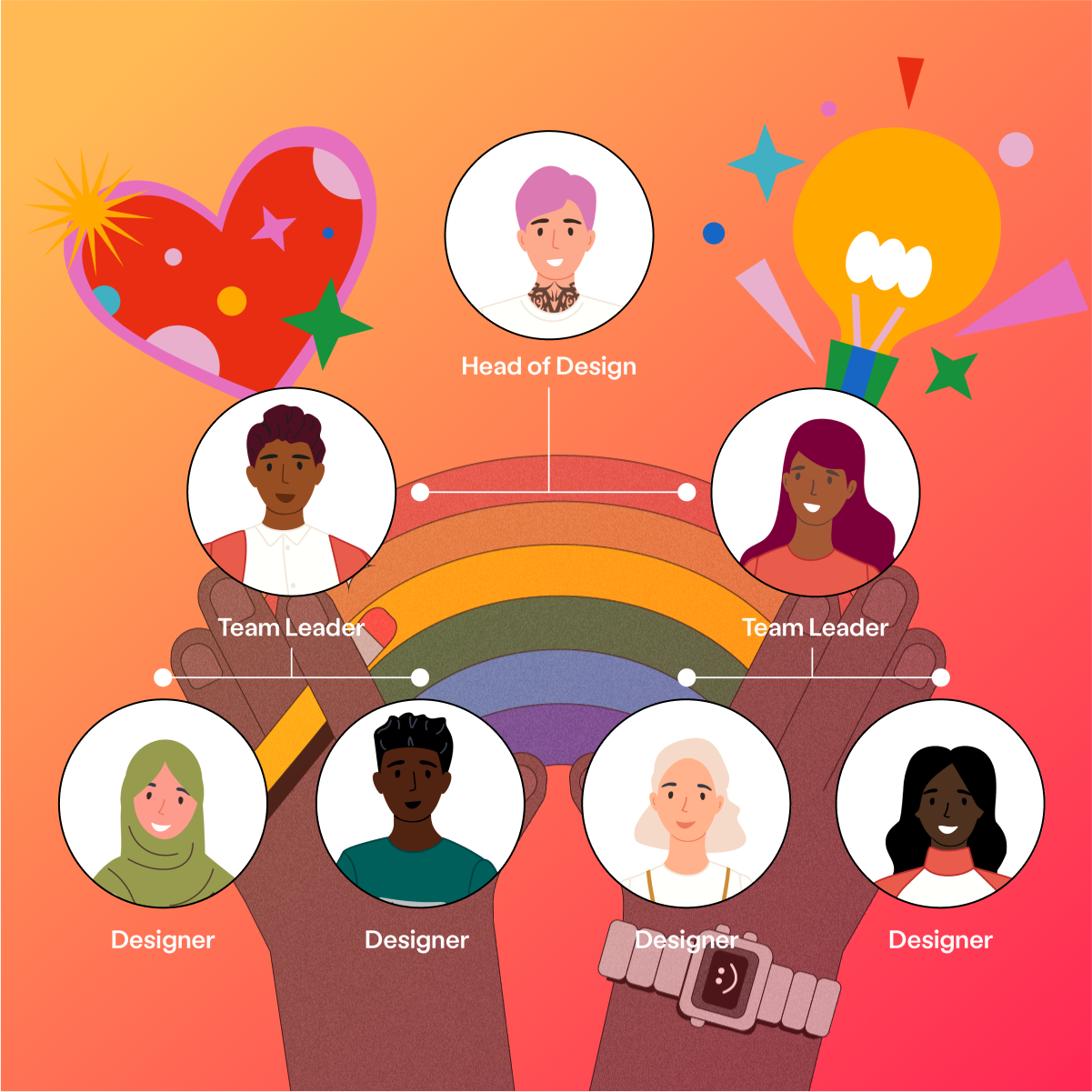
In the dynamic world of design, a well-structured team functions as a blueprint for consistently delivering exceptional results. At its core, design team structure encompasses the hierarchy of designers, their distinct roles, and their responsibilities. It forms the backbone of collaboration, enabling seamless coordination and efficient utilization of skills.
But what constitutes a good design team structure, and how can you enhance its effectiveness? Let’s find out.
Defining design team structure
Setting up a clear and efficient design team structure is somewhat a complex undertaking, requiring careful consideration and a step-by-step process. First, you must explore some best practices for structuring a design team that brings out the best in each member and maximizes overall team performance.
Understand the composition of your design team
A design team is a blend of diverse professionals with varied skill sets. From graphic designers to UX/UI designers, illustrators, and researchers, each team member contributes their unique expertise and perspective to the overall design process.
Understanding the composition of your team and leveraging their individual strengths is crucial for effective collaboration and successful project outcomes.
Define roles and responsibilities within the team
Assigning clear roles and responsibilities is the cornerstone of a well-functioning design team. For example, you may have a team lead responsible for overall coordination, decision-making, and guiding the team toward project objectives. You may also have a project manager who oversees the project's planning, scheduling, and budgeting aspects, as well as designers who are responsible for creating visual assets, wireframes, and prototypes.
By defining roles and responsibilities, team members understand their tasks, what is expected of them, and how their work contributes to the overall project. This clarity fosters a collaborative environment and synergy, helping to reduce conflicts or overlaps, and maximizing productivity within the design team.
Consider the key factors that will affect your design team structure
When setting up your team, you will also need to consider the various factors that will impact how you will work, and hence how your team is structured.
Project complexity
The complexity of a project directly influences the structure of the design team. For instance, projects with multiple facets and intricate requirements may benefit from a more specialized and diverse team structure. By assigning team members with specific skills to handle different design aspects, you can ensure the effective handling of complex projects and achieve optimal results.
Team size
The size of your team also plays a vital role in determining the structure. Smaller teams often thrive with flexible and collaborative structures that allow for free-flowing communication and shared responsibilities. Conversely, larger teams may require more defined roles and hierarchical arrangements to maintain efficient coordination and streamlined workflow.
Organizational goals
Aligning the design team structure with the overarching goals and objectives of your organization is paramount. Put another way, your design team structure should support and complement overall organizational goals and strategies, and contribute to the success of the organization as a whole.
For example, if a company wants to become a leader in the industry, the design team can support this goal by developing a strong and cohesive brand identity that aligns with the company's values and resonates with the target audience.
Desired outcomes
The structure of your team should be designed to maximize the team's ability to achieve your desired outcomes efficiently and effectively. For instance, if fostering innovation is a primary goal, a structure that promotes cross-functional collaboration and idea-sharing would be more suitable, nurturing a creative and forward-thinking environment.
Skill sets and expertise
Before settling for a specific team structure, it’s essential to assess the required skill sets and expertise for the project or tasks at hand. This way, you will have the right combination of skills to meet project requirements, enabling seamless execution and high-quality deliverables.
Once you have a good understanding of these factors, you can then determine your team structure.
Common design team structures
Design teams come in all shapes and sizes, but there are a few common structures that are used by companies and teams worldwide.
Functional structure
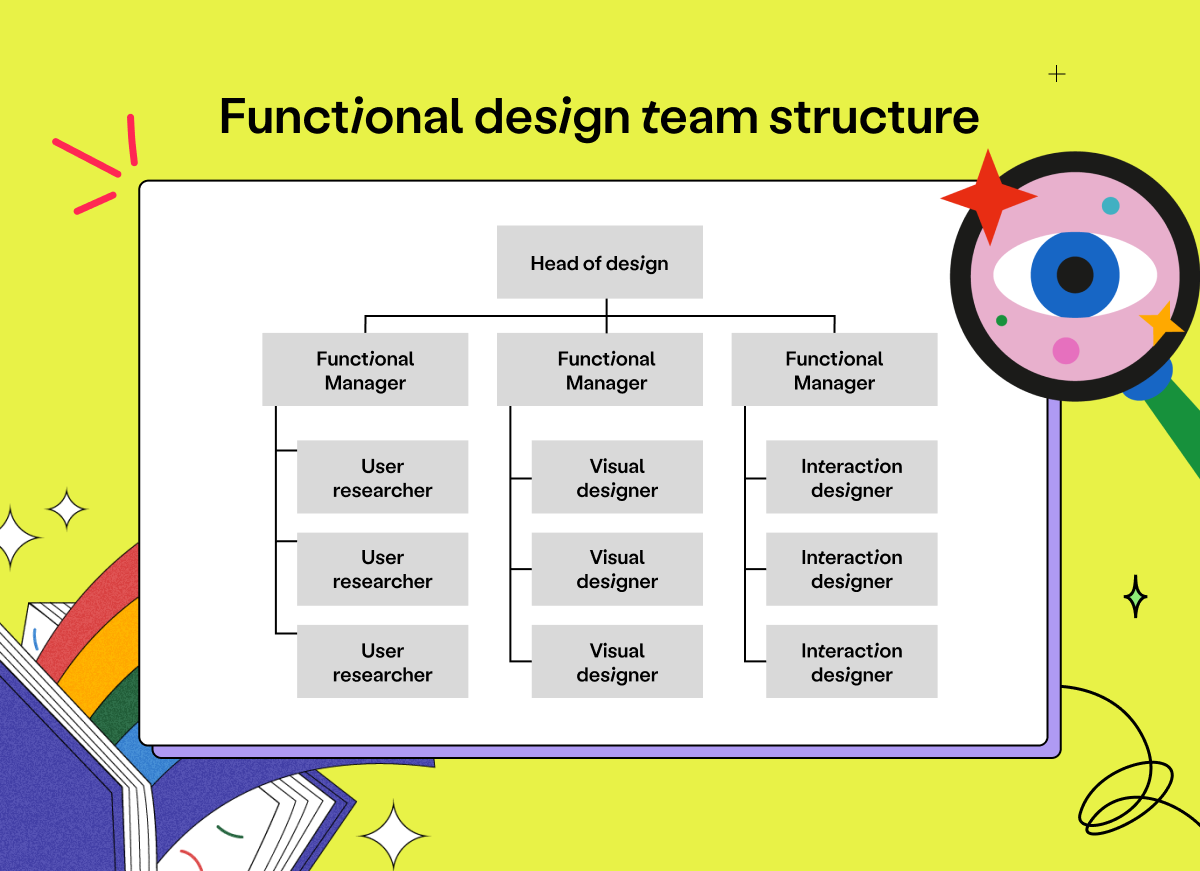
In a functional design team structure, members are grouped based on their areas of expertise or functions, such as user research, visual design, or interaction design. Each functional group operates independently, focusing on its specific domain.
Pros
- Specialization and expertise: The functional structure allows team members to specialize and develop deep expertise in their respective areas. This is because they can sharpen their skills within their functional domain, enabling them to become subject matter experts.
- Productivity and efficiency: Functional groups can work efficiently since team members have a clear understanding of their roles and responsibilities within their specific functions. This clarity facilitates streamlined workflows and faster decision-making, as team members can leverage their expertise to tackle specific tasks efficiently.
- Consistency and quality: With specialized functional groups, there is a higher likelihood of delivering high-quality and consistent work. Each group can focus on refining and improving their respective areas, resulting in a higher level of craftsmanship and attention to detail.
Cons
- Limited cross-functional collaboration: In a functional structure, there may be minimal interaction and collaboration between different functional groups. This can lead to silos, where each group works independently without considering the perspectives and insights of other team members, thus hindering innovation and resulting in suboptimal solutions.
- Communication challenges: When functional groups operate independently, there can be communication challenges between different functions. Miscommunication or limited information sharing may occur, leading to misunderstandings or missed opportunities for collaboration.
- Integration difficulties: In projects that require multiple functional areas to work together, the functional structure may face challenges in integrating different components effectively. Coordinating efforts between functional groups, such as aligning visual design with user research insights, may require additional effort and coordination.
- Slow response to change: Functional structures can be less adaptable to change compared to more flexible team structures. For example, when a project requires cross-functional collaboration or a shift in priorities, the functional structure may face difficulties in quickly reallocating resources and adjusting workflows.
Cross-functional structure
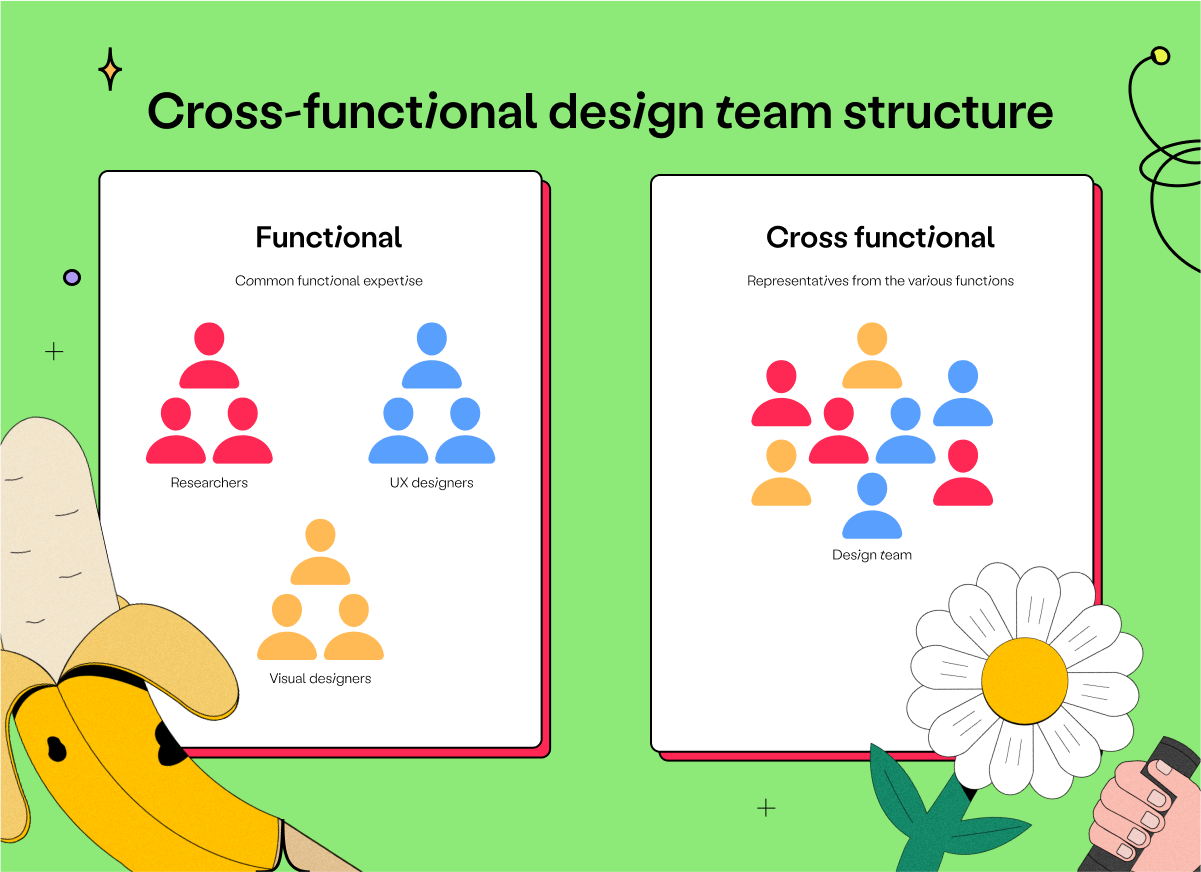
A cross-functional design team structure brings together individuals from different disciplines and skill sets into a single team, promoting collaboration and a holistic approach to problem-solving.
Pros
- Improved collaboration: Cross-functional teams facilitate collaboration, which leads to a broader range of solutions and encourages innovation. For instance, the combination of various disciplines allows for a more holistic approach to design, considering factors such as aesthetics, usability, technical feasibility, and user insights.
- Better knowledge sharing: In a cross-functional team, individuals from different disciplines have the opportunity to learn from one another and leverage their diverse perspectives. This can spark creativity and foster a culture of continuous learning and improvement.
- Faster decision-making: Cross-functional teams are empowered to make decisions independently, reducing the need for hierarchical approvals and dependencies on other departments. This autonomy enables faster decision-making, allowing the team to be more agile and responsive to project requirements and changes. It also promotes a sense of ownership and accountability among team members.
Cons
- Coordination and communication problems: Aligning individuals from different disciplines with diverse perspectives can introduce coordination and communication problems.
- Potential for power struggles and conflict: Cross-functional teams may face challenges related to conflicting priorities, differing opinions, or power struggles among team members. With multiple disciplines and expertise involved, disagreements on approaches or design decisions can arise
- Learning curve and skills gaps: In a cross-functional team, individuals may need to acquire a basic understanding of other disciplines to facilitate effective collaboration. This learning curve and skill gaps can be a challenge, especially in the initial stages.
Matrix structure
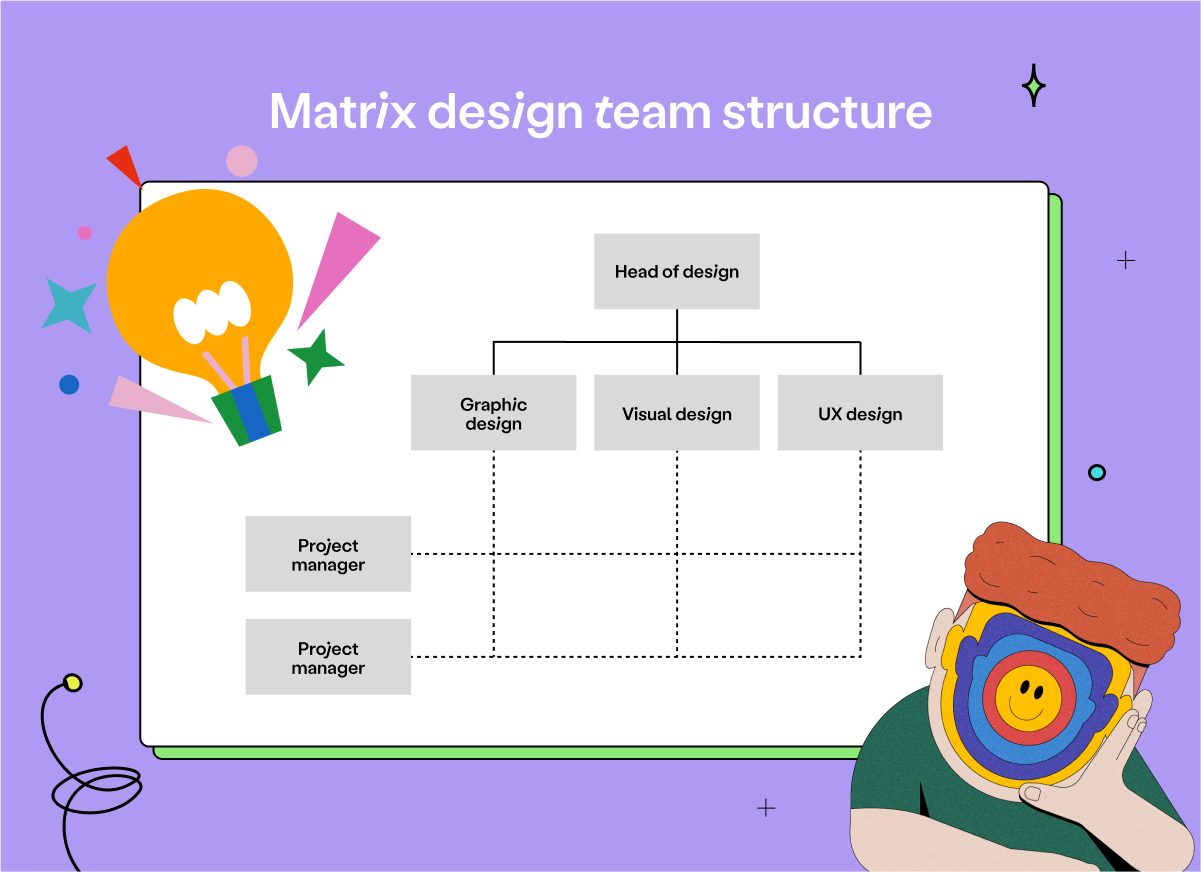
The matrix design team structure combines elements of functional and cross-functional structures, providing both specialized expertise within functional areas and collaboration across projects. For example, a visual designer may be a part of the visual design team but also work closely with a project team on specific projects.
Pros
- Specialized expertise: The matrix structure allows team members to maintain their specialized expertise within functional areas.
- Collaboration and interdisciplinary approach: By belonging to both a functional team and a cross-functional project team, team members can collaborate across disciplines and bring their specialized knowledge to project-specific tasks. This fosters interdisciplinary collaboration, where individuals from different functional areas work together to achieve project goals.
- Effective communication: The matrix structure promotes effective communication among team members. With frequent interaction between functional and project teams, information sharing, coordination, and feedback exchange become streamlined, enhancing overall project efficiency and success.
Cons
- Complexity and potential conflicts: The matrix structure introduces complexity due to multiple reporting lines, as well as overlapping roles and responsibilities. This can lead to potential conflicts, role ambiguity, and challenges in managing competing priorities.
- Decision-making challenges: With multiple stakeholders and reporting lines, decision-making processes in the matrix structure can become more complex. Plus, resolving conflicting viewpoints and ensuring alignment between functional and project teams may require additional effort and coordination.
- Power struggles and accountability: The matrix structure can sometimes lead to power struggles or challenges in establishing clear accountability. Team members may find it difficult to navigate between the authority of functional team leaders and project team leaders, potentially impacting collaboration and decision-making processes.
Project-based structure
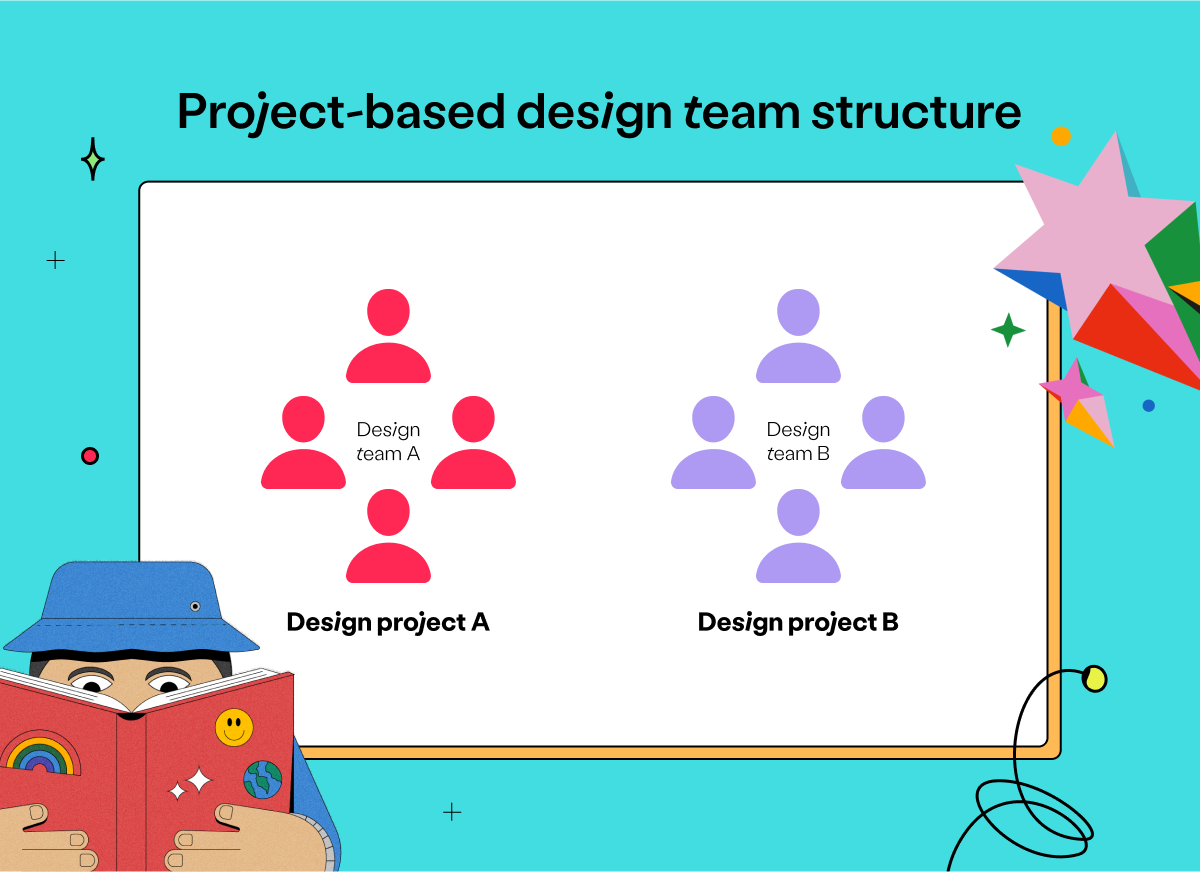
In a project-based design team structure, teams are formed specifically for each project or initiative. In other words, a team is assembled with members who have the necessary skills and expertise for the particular project. When the project is completed, the team disbands, and the members may join other project teams.
Pros
- Dynamic team compositions: The project-based structure brings together individuals with the necessary skills and expertise for the specific project requirements. This flexibility ensures that the team has the right talent to tackle the project effectively.
- Team size flexibility: Depending on a project's scope and complexity, team size can be adjusted accordingly. Smaller teams may be suitable for smaller projects, while larger teams can be assembled for more significant endeavors. This adaptability ensures that the team size aligns with the project's needs, enhancing productivity and collaboration.
- Efficient resource allocation: The project-based structure enables more efficient resource allocation. For instance, resources, including personnel, budget, and equipment, can be allocated specifically to support each project's requirements, allowing for optimized utilization of resources and cost-effectiveness.
Cons
- Lack of knowledge transfer: With team members frequently transitioning between projects, ensuring effective knowledge transfer — for example, capturing lessons learned, best practices, and project-specific knowledge and disseminating them to the wider organization — can be challenging.
- Project management issues: The project-based structure relies heavily on effective project management. Insufficient project management capabilities can lead to project delays, cost overruns, and quality issues.
- Team collaboration and cohesion: As project teams frequently change, maintaining team cohesion and fostering effective collaboration can be a challenge.
Hierarchical structure
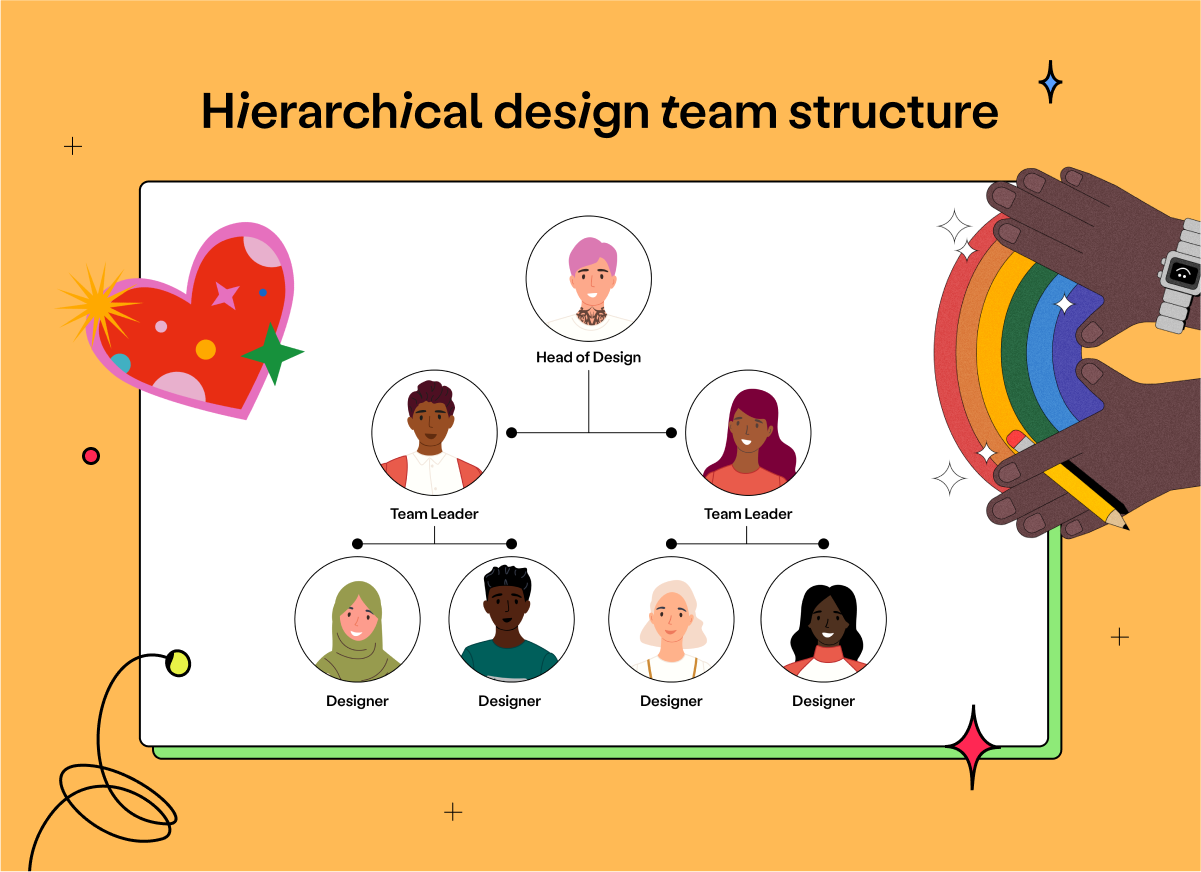
A hierarchical design team structure follows a traditional organizational hierarchy with clear levels of authority and reporting lines. It may include design managers, team leads, and individual designers, for example. The hierarchical structure is often effective for large design teams, where clear lines of communication and management are crucial.
Pros
- A clear chain of command: A hierarchical structure provides a clear chain of command and reporting lines, with each team member reporting to a higher-level manager. It establishes a formal structure where roles and responsibilities are well-defined, ensuring clarity in decision-making processes and accountability.
- Improved processes: With clear authority and reporting lines, it’s easy to see who is responsible for making decisions and handling tasks or processes. This helps to streamline workflows and avoid potential bottlenecks.
- Role clarity: The hierarchical structure defines roles and responsibilities, reducing ambiguity within the design team. Each team member knows their position, tasks, and reporting relationships, which promotes efficiency and reduces conflicts arising from overlapping responsibilities.
Cons
- Limited autonomy and creativity: In a hierarchical structure, decision-making authority is typically concentrated at higher levels, and lower-level team members may have limited opportunities to contribute their ideas and creative solutions. This can limit autonomy and creativity in the team.
- Slower decision-making processes: While the hierarchical structure, decision-making authority may need to flow through multiple levels, causing delays and hindering agility, especially when time-sensitive decisions are required.
- Potential communication barriers: The hierarchical structure can create communication gaps, particularly when information needs to travel through multiple levels of authority. Messages can become distorted or delayed, leading to miscommunications or misunderstandings within the design team.
Design team structures vary in their benefits and drawbacks, and the choice should align with your team's needs. You may even find a mix of structures necessary to meet your specific objectives. That said, there are ways to enhance team structure, regardless of your structure choice.
Assessing and improving your design team structure
The following are some top ways to assess and improve your team structure:
- Evaluate the current structure: Before making any changes, you must assess the strengths and weaknesses of the existing design team structure. This can be done through feedback surveys, team meetings, or individual discussions.
- Determine improvement areas: Based on the evaluation, you can then identify improvement areas. Common areas include communication gaps, decision-making processes, and collaboration issues. By pinpointing these areas, you can develop targeted strategies for improvement.
- Implement changes: Implementing changes to the design team structure requires careful planning and communication. Develop a transition plan that outlines the steps, timelines, and responsibilities involved. Communicate the changes transparently to the team, addressing any concerns or questions. You will also need to regularly monitor the new structure and make adjustments as needed.
Ultimately, your design team structure must promote effective communication and collaboration, build a positive team culture, and encourage professional growth among team members.
Create an effective design team with help from Playbook
A well-structured design team can make all the difference in delivering client satisfaction. However, team structure alone can only take you so far. To truly succeed, you need exceptional management that fosters productivity, collaboration, and creativity within the team.
One valuable tool for effectively managing your design team is Playbook. Playbook serves as a comprehensive collaboration and file management tool, empowering designers to effortlessly view and share files, collaborate on projects, and track progress.
The Opendoor design team attests to the power of Playbook, describing it as a unifying force within their team. Nicolas Solerieu, who was then a Senior Brand Designer at the company, emphasized Playbook’s tremendous impact, stating, "We were aligned before. Now we're really aligned! I now know that we don't need to waste time rummaging through folders looking for resources.”
Curious about how other creative teams are leveraging this game-changing tool to elevate their work to new heights? Check out Invictus Media’s journey with Playbook.
